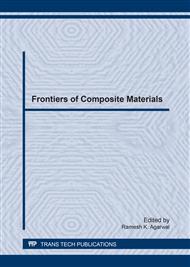p.66
p.72
p.76
p.81
p.85
p.89
p.94
p.99
p.104
Sintering Behaviour and Properties of Flyash-Doped Zirconia
Abstract:
The effect of flyash (FA) additions of 0.05 wt% to 1 wt% on yttria-stabilized tetragonal zirconia polycrystals (Y-TZP), sintered in air at temperatures ranging from 1250°C to 1500°C, was examined. The bulk density, Young’s modulus, Vickers hardness and fracture toughness for each addition were determined while ageing behaviour were observed by subjecting them to superheated steam at 180°C/10 bar in an autoclave for 24 hours. Additions of FA, particularly of 0.05 wt% and 0.1 wt%, were found to be beneficial in aiding densification and increasing Young’s modulus beyond 200 GPa for sintering temperatures up to 1350°C. A common trend was observed for the Vickers hardness of all additions including undoped; hardness continues to rise from 1250°C and peaked at 1350°C before gradually decreasing as the sintering temperature increases further. No pronounced effect of flyash was seen on the fracture toughness of all samples. The ageing resistance of Y-TZP improved with addition of FA resulting in relatively lower amount of ageing-induced tetragonal to monoclinic phase transformation exhibited by doped samples compared to the undoped.
Info:
Periodical:
Pages:
85-88
Citation:
Online since:
March 2017
Authors:
Keywords:
Price:
Сopyright:
© 2017 Trans Tech Publications Ltd. All Rights Reserved
Share:
Citation:


